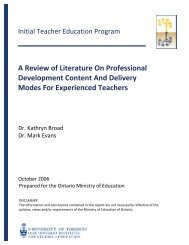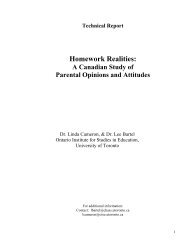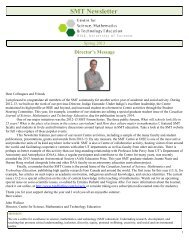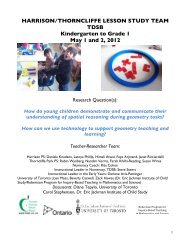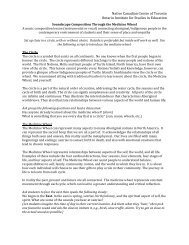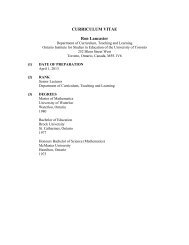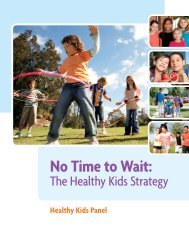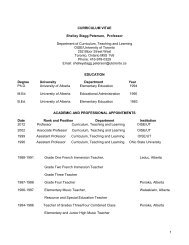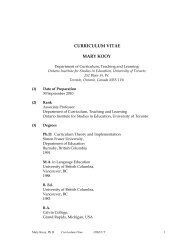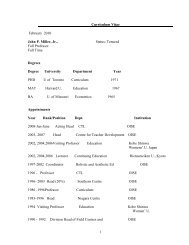The Ontario Curriculum, Grades 9-12 - Ministère de l'éducation ...
The Ontario Curriculum, Grades 9-12 - Ministère de l'éducation ...
The Ontario Curriculum, Grades 9-12 - Ministère de l'éducation ...
You also want an ePaper? Increase the reach of your titles
YUMPU automatically turns print PDFs into web optimized ePapers that Google loves.
Environmental Science, Gra<strong>de</strong> 11, Workplace Preparation<br />
(SVN3E)<br />
A. Scientific Investigation Skills and Career Exploration<br />
A2. Career Exploration<br />
A2.1 i<strong>de</strong>ntify and <strong>de</strong>scribe a variety of careers related to the fields of science un<strong>de</strong>r study (e.g.,<br />
hydro meter rea<strong>de</strong>r, hospitality employee, waste management operator, custodian) and<br />
the education and training necessary for these careers<br />
B. Human Impact on the Environment<br />
B1. Relating Science to Technology, Society, and the Environment<br />
B1. analyse selected current environmental problems in terms of the role human activities have<br />
played in creating or perpetuating them, and propose possible solutions to one such problem<br />
B1.1 propose possible solutions, on the basis of research, to a current practical environmental<br />
problem that is caused, directly or indirectly, by human activities [IP, PR, AI, C]<br />
Sample issue: Car emissions contribute to smog as well as global warming. Road tolls and<br />
increased use of public transit to cut down on the number of cars on the road, and the<br />
implementation and enforcement of idling by-laws, could significantly cut these emissions.<br />
Sample questions: How can various kinds of chemical spills in local ecosystems (e.g.,<br />
fields, rivers, streams) be cleaned up? In what ways does improper sewage treatment or<br />
agricultural run-off threaten local water supplies, and how can these dangers be addressed<br />
or averted? What can be done to minimize the effect of an invasive species (e.g., purple<br />
loosestrife) on a native species (e.g., milkweed)?<br />
B1.2 analyse the risks and benefits to the environment of human recreational activities and the<br />
leisure industry [AI, C]<br />
Sample issue: Ecotourism attempts to reduce the waste and environmental damage<br />
associated with mass tourism. Although responsible ecotourism seeks to conserve local<br />
ecosystems through sustainable practices, and can, for example, help reduce <strong>de</strong>forestation<br />
and animal poaching rates, any human intrusion can damage fragile ecosystems.<br />
Sample questions: What are the risks to the environment of herbici<strong>de</strong> use and water<br />
consumption on golf courses? What are some of the risks and benefits to the environment<br />
of landscaping? In what ways can hunters and fishers damage the environment? In what<br />
ways can they contribute to its sustainability? What rules are nee<strong>de</strong>d to ensure that<br />
visitors to a protected area do not harm that ecosystem?<br />
B2. Developing Skills of Investigation and Communication<br />
B2. investigate air, soil, and water quality in natural and disturbed environments, using<br />
appropriate technology<br />
B2.1 use appropriate terminology relating to the environmental impact of human activity,<br />
including, but not limited to: carbon footprint, carbon neutral, bio<strong>de</strong>gradable,<br />
biodiversity, carrying capacity, sustainability, and invasive and native species [C]<br />
B2.2 plan and conduct an inquiry, using appropriate technology, to compare soil quality in<br />
natural and disturbed environments (e.g., compare the phosphorous content, pH, organic<br />
Science 139



